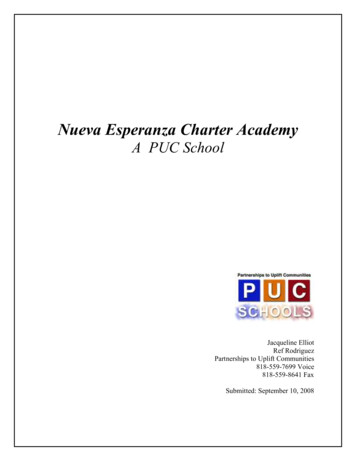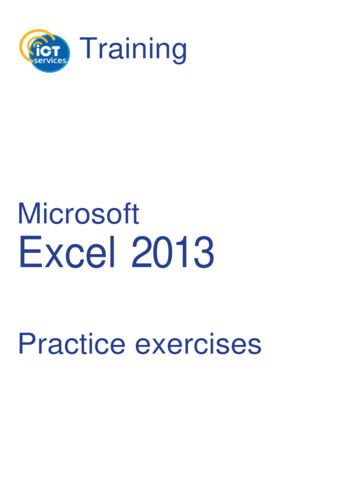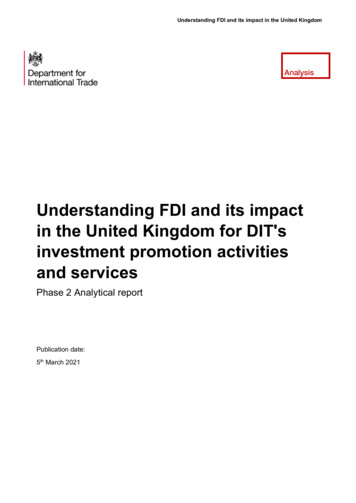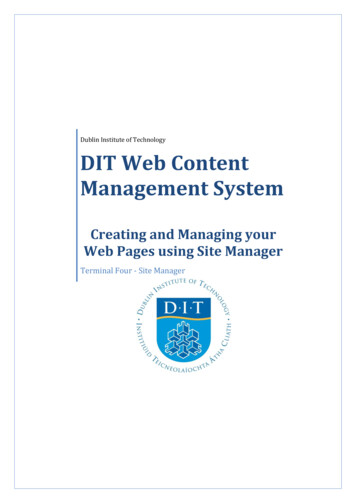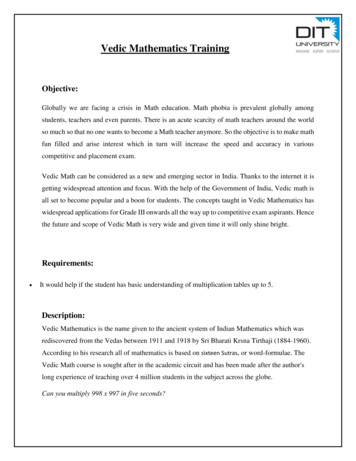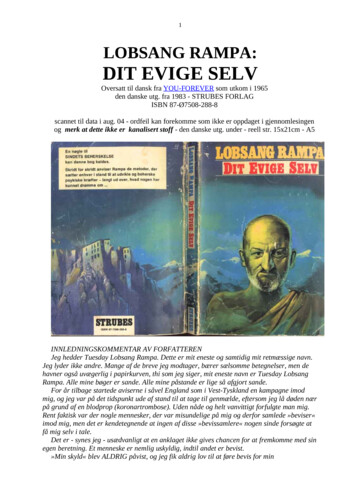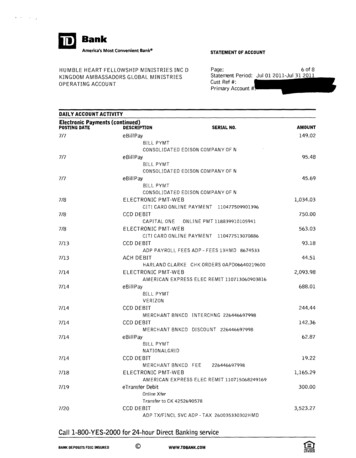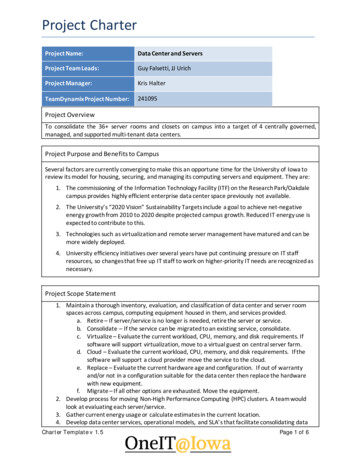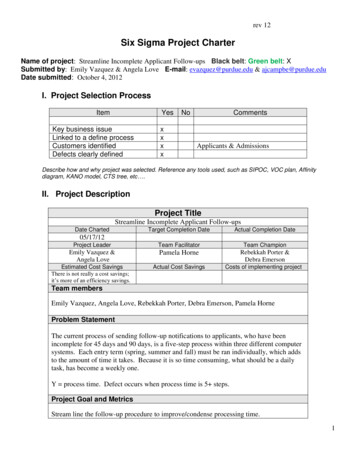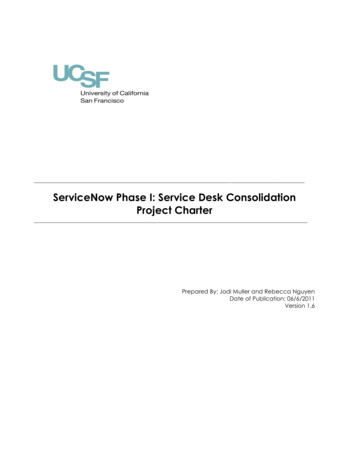
Transcription
Programme Management OfficeProject Charter & Scope StatementProject Title:Project ID:Project Sponsor:Project Manager:Charter approval date:Programme & Module Data IntegrationBrian Norton, PresidentLiam Duffy, IS ServicesDocument ControlDate30-01-1202-02-12Versionv0.1V2.0Changed byLiam DuffyLiam DuffyReasons for ChangeOriginal DocumentConsultation with SponsorDistribution ListNameBrian NortonDavid ScottMichael MulveyNoel O’ConnorPaul FlynnBrendan RuddyJane MurphyMargaret WhelanRoleSponsorCISODirector, Academic AffairsDirector, Student ServicesDirector, FinanceOperations Manager, AcademicAffairsPMOSDSTIS Project Charter .whelan@dit.ie
ISPMO Project Charter1. PROJECT ORGANISATION1.1 PROJECT SPONSORThe Project Sponsor is the client side representative who acts as a single focal point ofcontact with the project manager for the day-to-day management of the interests of theproject. The person in this role must have adequate knowledge and information aboutthe business and the project to be able to make informed decisions.1.2 PROJECT MANAGER:The Project Manager is the individual responsible for delivering the project. TheProject Manager leads and manages the project team, with the authority andresponsibility to run the project on a day-to-day basis.1.3 PROJECT BOARD MEMBERS:Project board members should be formallyappointed with specific remit to assist in decisionmaking and on-going progress of the project.1.4 PROJECT BOARD RESPONSIBILITIES (ifdifferent from agreed responsibilities on ISPMOwebsite)1.5 RESOURCES PREASSIGNED: Brian Norton,PresidentLiam Duffy, SeniorProject Manager, ISServicesBrendan Ruddy, Academic AffairsJennifer Farrell, Student ServicesMarie, Kennedy, SDSTAndy Myler, Fees & IncomesGillian Donagher, IS Development Represent the function(s) who s/he represents andensure that effective communications and feedbackto stakeholders. Make key decisions on behalf of the function(s)whose interests s/he is representing on the Board. Make board level decisions and promote theimplementation of all project decisions. Take individual responsibility as required toresolve key issues. Provide demonstrable support to the ProjectManager, partners, team and the user communityHow many or what resources will be assigned to theproject?Level of involvement of Academic Affairs & IS Development Staff is expected to be high, requires detailedplanning to measure Academic Affairs- Quality Assurance (High)Student 2 of 35
ISPMO Project Charter Colleges Managers Finance & Resources -Fees & Incomes-IS Development Staff (High)Strategic Development Services1.6 STAKEHOLDERS:Who will affect, or be affected by, the project (influencethe project) as known to date? Please provide details. Academic Affairs & Registrar All Colleges Student Services (Registrations, Exams & Timetabling) IS Services Office of the PresidentFurther details of Roles & Responsibilities available on the “Project Roles” pages of the ISPMO website.2. SCOPE STATEMENT2.1 SCOPEThe scope should define the boundaries of the project. What is included in theproject? Only work specified in this document is included in the project. Provide a mechanism of obtaining consistent programme and module data across all IS system (List ofsystems affected see appendix 1) Agree required business process around programme, module and related data approval and entry to systems Have a single point of entry for all programme and module data including CRN’s and components Verify and correct all existing data Control programme, module data (incl. CRN’s and components), approval and entry to systems to theAcademic Affairs and Registrar following Academic Council approval Reflect programme, module data within the current Organisational Structure of DIT i.e. the CollegeStructure Remove all user rights to create, change or delete programme, module or related data from IS Systems otherthan through the Quality Assurance Office2.2 OUT OF SCOPEPlease provide a clear statement of what this project will not include Integration of third party systems Campus IT & Apply on Line with the Banner Student System Virtual University2.3 DELIVERABLESKNOWNList the high level project outputs whose satisfactory delivery mark thecompletion of the project i.e. Tender \ supplier agreed, working computer code,user training.Cannot complete this section without detailed discussion with the primary stakeholders 02/02/20123 of 35
ISPMO Project Charter2.4 PROJECT SUCCESSSpecify what must be done in order for the project to be considered a success byits stakeholders.Cannot complete this section without detailed discussion with the primary stakeholders 3. REQUIREMENTS \ ASSUMPTIONS \ CONSTRAINTS \ DEPENCENCIES \RISKS3.1 STAKEHOLDERREQUIREMENTSPlease describe any additional features that describe the desirable outcome of theproject.Cannot complete this section without detailed discussion with the primary stakeholders 3.2 ASSUMPTIONSThese are items which are uncertain and are presumed about the project This project is the number one priority project for 2102 [Agreed by Facilities, ITCommittee – 17th January 2012) Coursewise is the definitive source of data [See also constraints] Resources (Financial and Staff) will be made available to the project when required and in a timely manner Decisions will be made in a timely manner Interdependencies between projects will be managed Data will be available by the required dates3.3 CONSTRAINTS& ProcurementThese are items which are known and impose restrictions on the project, i.e. Time,Resources, Cost, Project timeline fixed at 30th June 2012 for completion Coursewise is the definitive source of data, this may impact on how we progress [See also Assumptions] Project is being implemented on multiple moving targets (Coursewise, Banner, CMIS etc.) e.g. CMIS iscurrently being upgraded Banner term roll needs to occur after 20th June and before 30th June and some changes cannot happen untilafter that period we may there fore have to phase some implementation CMIS Term Roll occurs in late April, programme & module data for the coming year should be available atthat time CAO loads must commence in July and all programme data needs to be in Banner for that time, hence 30thJune is fixed Automating some processes may be cost prohibitive and extremely difficult to achieve, this needs to beassessed Department of Finance Directives 02/09 and 02/11 – adherence to will lead to time delays02/02/20124 of 35
ISPMO Project Charter3.4 DEPENDENCIESA dependency is an item outside of the projects direct control but on which it dependsand without which time, cost or quality will be affected. NQAI Review and related projects [dependencies need to be assessed] HEA Returns Project – Needs to be completed Agresso and Core Projects – Organisational Structure feeds to Banner through interfaces3.5 RISKSA risk is any item outside of the projects direct control which may affect the successfuldelivery of the project, or may impact negatively on the project timescale, cost orquality.Risks not listed in any particular order of magnitude Banner System and its related hardware / software is currently in a de-support status, it is never advisableto develop in an un-supported environment – See Appendix 4 Banner 8.5 project may constrain what we can achieve Development completed in Banner 7.4 environment needs to be upgraded / re-developed for Banner 8.5environment, may require us to change how the interface will work for a Banner 8 environment NQAI Review requirements (Projects under this initiative are not currently defined and have conflictingtimelines) – Appendix 5 All other projects on the Facilities, IT & Procurement Committe approved list for 2012 and the demandsthey place on resources and timelines Project timelines are extremely aggressive Insufficient time to adequately plan project or assess options Availability of resources including external resources as there are lead times of 2 to 3 months on bookingexternal resources Timelines for required procurement process is likely to be months Operational demands on staff (IS & Functional) may impact on their availability for project related work Changes in the Organisational Structure will affect multiple systems and needs to be synchronised as achange in one system may cause the interfaces between the systems to fail4.PROJECT CHARTER APPROVALI have read the information contained in the charter document and recommend approval to proceed:NameSignatureDateApproval signature (Project Sponsor)Approval signature (Project Manager)02/02/20125 of 35
ISPMO Project CharterAppendicesAPPENDIX 1- IS SYSTEMS POTENTIALLY AFFECTED BY PROJECT Programme & Module CatalogueStudent & Academic RecordsTimetablingE-LearningDiploma SupplementStudent Admissions (Programme data only)TLT Grants SystemHR / Payroll & Student ID CardHEA Returns- Coursewise- Banner- CMIS- Web Courses- Digitary- Campus IT & Apply on-line- TLT- CorehrNOTE: DURING THE PROJECT OTHER SYSTEMS MAY BE IDENTIFIEDAPPENDIX 2 – BRIEF DATA COMPARISONProgrammes [Data as of 3pm 27th Jan 2012) There are 307 programmes in Coursewise.There were 336 programmes returned to the HEA in October with students attached.There are currently 372 programmes with registered Students in BannerThere are currently 622 Programmes in CMISModules [Data as of 3pm 27th Jan 2012) Hard to map due to lack of CRNs in coursewiseThere are 5,179 modules in CoursewiseThere are 3,253 modules in Banner with at least 1 student registered for the currentterm (Noting S2 Students probably not registered)There are 6,958 modules setup in Banner for 201112 (likely a lot not in use)There are currently 9,299 Modules in CMISNOTE: A random selection of two programmes from each of the four colleges was carried out to do a three waycomparison between the Programme Documents, Coursewise and Banner. Significant differences wereidentified.02/02/20126 of 35
ISPMO Project CharterAPPENDIX 3- INTEGRATION OPTIONS PRESENTED BY SUNGARDHECoursewise integration optionsCoursewise / is an application developedlocally at DIT by Academic Affairs that displays programme and module information tostudents, prospects and staff. Through a login screen academic staff (or those authorised) canset up new programmes and modules, and maintain them. At present the application is beingused as a point of reference only and is not integrated with any other systems.DIT wants to use Coursewise as a single point of entry for all programme and moduleinformation. Coursewise is then to be integrated with Banner so data is consistent. Data willalso be used in other DIT systems (e.g. CMIS and Raisers Edge). These systems currentlyfeed from Banner.Coursewise has been developed in the past two years outside DIT s usual framework and itnow needs to be brought into the fold and will be managed by Information Services. It hasbeen developed using Django but at this stage there is not a full understanding of the databasebehind it including the data structures. Coursewise currently has a single point of failure,limited documentation and no test instance. Information Services need to spend timediscovering more about Coursewise to be able to support it in the short term at least whilstthe integration options are being considered.The project deadline is June 2012 and this is the single most important project InformationServices is to work on.I agree there should be one single point of entry for all programme and module information,yet I also believe we need to consider the approvals process for quality assurance reasons.The detailed requirements of this project are still to be specified but I think the options toconsider are:1. An integration between Coursewise and Banner using the Infinity Process Platform(IPP) as the integration tool2. Implementation of a new version of Coursewise using the Programme and ModulesApprovals system developed through Infinity Process Platform (IPP) as a basis3. Implementation of a new version of Coursewise using the Programme Cataloguedelivered in Banner and enhancements using the Self Service Engine02/02/20127 of 35
ISPMO Project CharterOption 1: Integration between Coursewise and Banner using IPP as the integration toolThis option utilises the existing Coursewise as the single entry point for programme and module dataentry and maintenance, and uses the IPP tool to integrate with Banner.Firstly, a full technical analysis of Coursewise would be required to see if it can turned into a fullysupported application by Information Services. Concerns already include: Development has been done outside DIT s usual framework Lack of knowledge and skill set to support Django Lack of information on longevity of Django Limited documentation Lack of a test systemOnce this analysis is complete, Information Services will need to decide if this is a technically viableand strategic way forward. If this is not the case, one of the other options should be followed or thecost of bringing Coursewise to the required standards needs to be calculated (if indeed this is possible)and used in the decision making process.If Information Services agree this is a technically viable and strategic way forward, a full functionalanalysis would be required to see if it meets the needs of the users. The analysis should involvediscussions with all stakeholders, including; Coursewise users with logins Representative staff and prospects and students that use the Coursewise live webpage Those involved in quality assurance at institution, college and school level Those that would hope to use Coursewise outputs in their systems in the futureAnalysis should involve finding out who currently uses Coursewise and what they like and do not likeabout the system, and
ISPMO Project Charter 02/02/2012 2 of 35 1. PROJECT ORGANISATION 1.1 PROJECT SPONSOR The Project Sponsor is the client side representative who acts as a single focal point of contact with the project manager for the day-to-day management of the interests of the project. The person in this role must have adequate knowledge and information about

